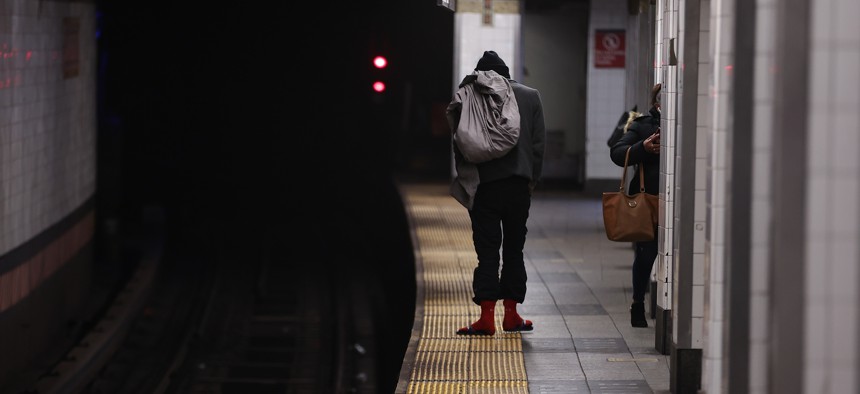“Mayor, Mayor, can’t you see? What your budget would do to me? Lock us up and keep us down. Ain’t no justice in this town.”
One thing was clear as I listened to the VOCAL-NY choir, led by Director of Organizing Jawanze Williams, as they sang that chant in City Hall Park Friday to protest Mayor Eric Adams’ emerging policies directed at unhoused New Yorkers: We need to heed the hard lessons COVID taught our town.
Those lessons, learned at the cost of 40,022 city resident lives, 67,191 statewide and 968,839 nationally to date, according to Centers for Disease Control statistics, were costly, and too many to list here. But two are grist for the protesters’ mill. Heeding one would change how the city deals with its unhoused residents. The other could be the key to our collective survival.
Mayor Adams, who on the campaign trail repeatedly offered the story of going through personal hard times in life that once forced him to live out of his car, gave the city’s unhoused a one-two punch to the gut in as many weeks since taking office. Last week he proposed a $615 million cut to the overall homeless services funds in his preliminary budget. This followed a January initiative, agreed to by the mayor and Gov. Kathy Hochul, that has New York City police officers rousing the homeless out of the subway cars and off platforms overnight, ostensibly to take them to shelters and supported facilities when available.
But many of the homeless would rather chance sleeping on the streets or in the relative safety of the brightly lit and constantly occupied subway cars and platforms overnight than hazard a night in shelter beds positioned three feet from your nearest neighbor.
Coming as it did after a succession of well publicized, heinous attacks in the city subways, including the January 15 death of 40-year-old Michelle Go, who was pushed in front of a train as it pulled into the Times Square station, the mayor’s move clearly conflates homelessness with criminal behavior, if not the unhoused with criminals. Yet many of these attacks were committed by the emotionally disturbed, as evidenced by 61-year-old Simon Marshall’s disjointed yells to reporters as he was arrested a day later for Go’s murder.
Unfortunately, the two most powerful Democratic officeholders in the state did not calculate on 30-year-old Gerald Brevard III shooting five homeless men March 3 through 12 as they slept on the street here and in Washington, killing two of them and providing a textbook example of the potential, deranged violence the unhoused face.
“I am really angry, really pissed off, that people on the street were targeted because they had no where to call home,” Housing Works Community Organizer Valerie Reyes-Jimenez said at the rally, drawing a chorus of amens from supporters. “Their home was under a scaffolding. Their home was the side of a building, their home was a steel grating. And because of that they were targeted and shot. “That ain’t right!”
But here’s the first pandemic lesson we can’t ignore: COVID’s harsh reality showed us the difference between how our city operates and how it could run. Our response to the pandemic proved New York City could house its unhoused in safe, comfortable, livable quarters. During those frightful, seemingly yearlong first months of the pandemic, when the death toll was so constant it overwhelmed city and hospital morgues so that hundreds of bodies had to be stored in refrigerated trailers, Mayor Bill DeBlasio moved thousands of unhoused out of crowded shelters and into vacant and leased hotel rooms across the five boroughs. You can’t socially distance yourself sleeping three feet away from your closest roommate.
Yes, FEMA money reimbursed much of the relocation, and people living near places like the Lucerne Hotel on the Upper West Side were rattled by the loitering, public urination and drug and alcohol use that the mentally ill and drug and alcohol addicted amongst their new neighbors brought with them. But the point is, to slow COVID’s deadly spread among city residents, officials found a way to securely, safely house thousands of the unhoused. So we can’t say it can’t be done.
We can’t even claim it would be too expensive, given that the city spent $3.5 billion on homeless services in fiscal year 2020. The roughly $42,705 dollars the city comptroller’s office estimates is spent annually on one shelter bed – $62,415 per family – could pay the rent for an apartment in much of our town. Yet 43,000 people, including 14,600 children, stayed in city shelters last week. WE can do better.
The second COVID lesson: Our country can still do big things. Yes, the CDC’s mask mandates continue to be confusing, the vaccine rollouts have been politicized, costing thousands of lives, and millions of our countrymen remain unvaccinated. Still, look what the government managed to do once folks who know how to run things took over – free vaccine shots available within months for millions of people, trillions in research grants, PPE loans and stimulus checks mailed out to keep the homebound nation financially afloat, and with more to come. Even trimmed by recalcitrant Republicans, what’s left of President Joe Biden’s trillion dollar Build Back Better plan will pump more money into the country’s failing infrastructure than any program since President Dwight D. Eisenhower’s construction of the national interstate highway system in the 1950s.
That’s a massive accomplishment, a really big deal. We need to get used to doing big things, because big challenges, like housing the unhoused, are everywhere. And they are done waiting for us to address them.
Clem Richardson is an author and former New York Daily News columnist.


